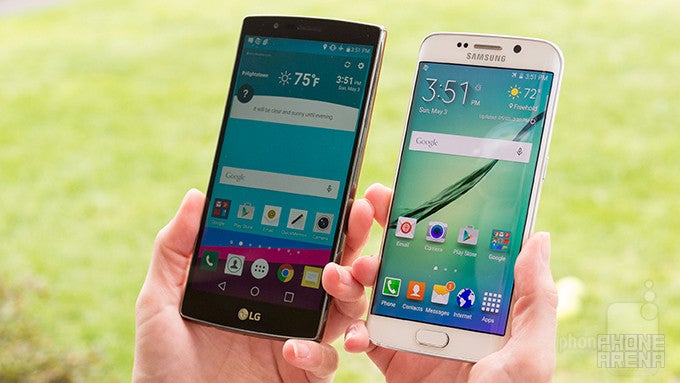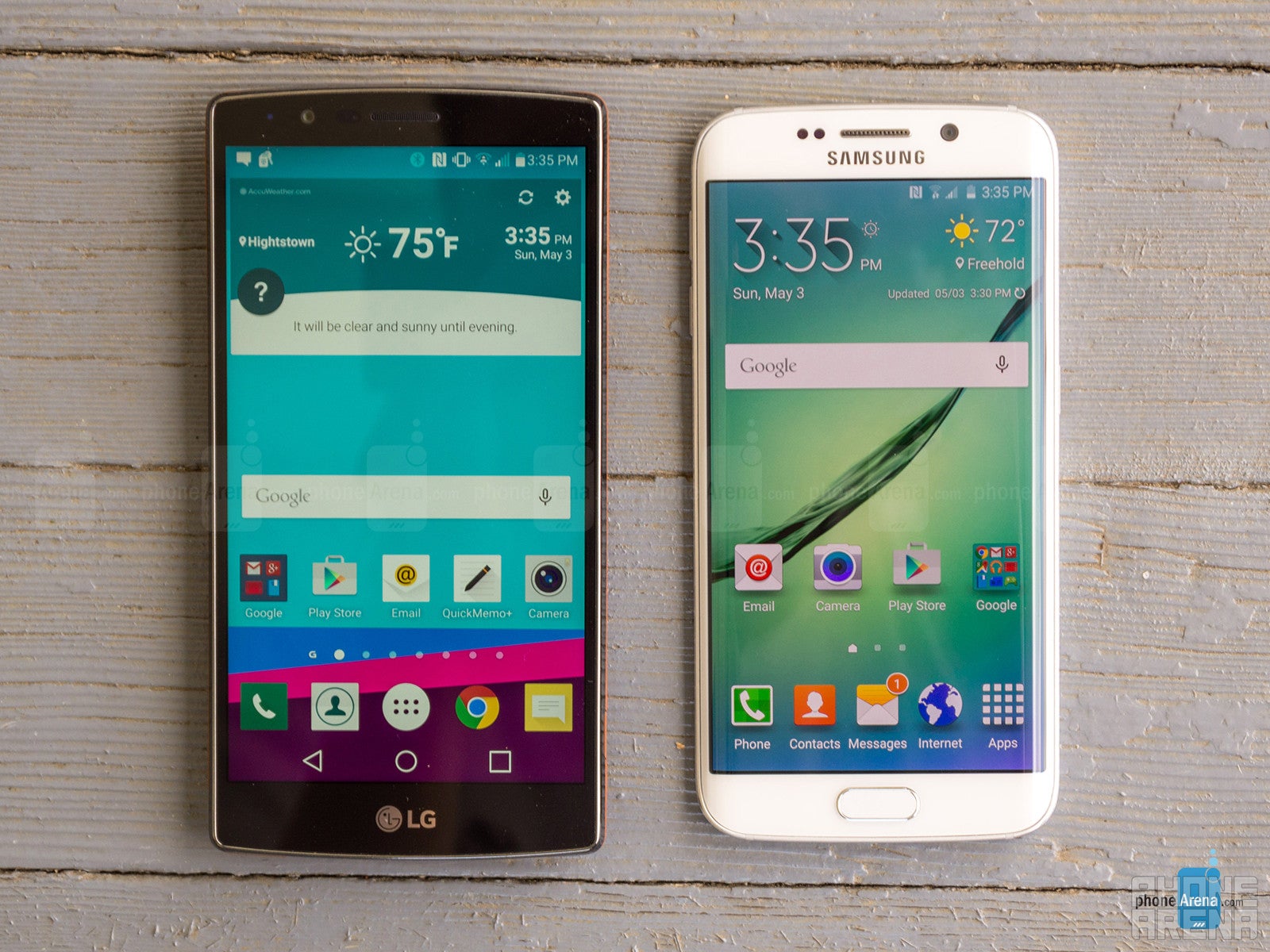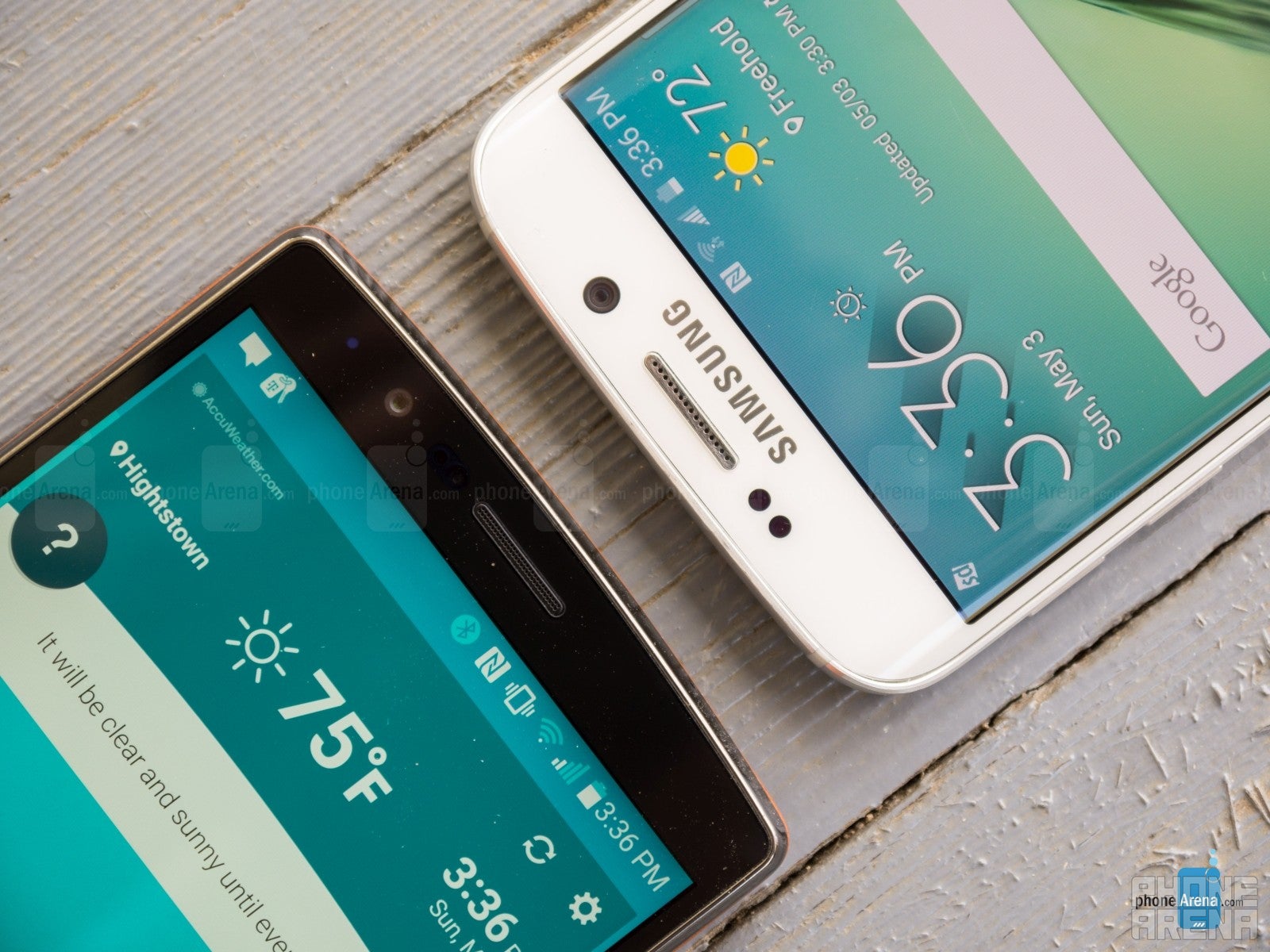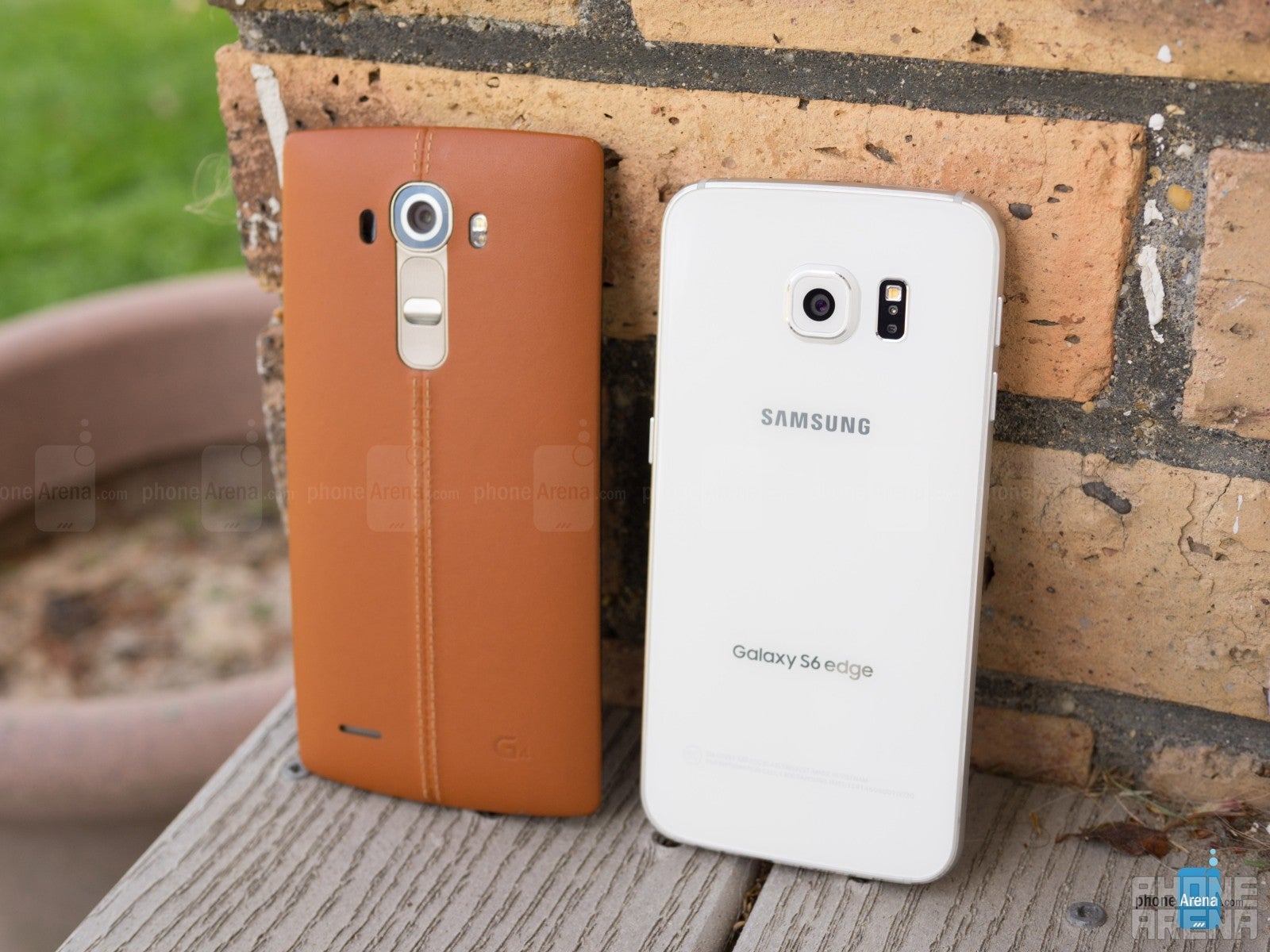LG G4 vs Samsung Galaxy S6 edge

Introduction
LG and Samsung have been in constant competition against one another for the last several years, but if we’re to strictly base their success on sales figures, it would arguably be Samsung who would claim bragging rights. Seriously, there’s nothing wrong coming in second place, but when it happens time after time, it really begins to eat at you – and it doesn’t help when you’re always in Samsung’s shadow either. More recently, too, the results haven’t changed a bit, as LG’s efforts have been in vain.
Already, Samsung is painting itself as one of the big winners for the first half of the year, just because its latest flagship line has been critically acclaimed. One of them in particular, the Samsung Galaxy S6 edge, is an incredible smartphone filled with beefy specs and a top-notch performance to make it a dream lover’s daily driver. However, it sets itself apart by its unique looking aesthetics brought on by its dual-curved display. LG, meanwhile, answers back with the new G4, which has the all the ingredients to make it a worthy successive phone.
Clearly, these two phones are rich in specs and powerful with their performances, but which of the two can be proclaimed as the superior handset? Let’s find out!
Design
Premium versus sophistication, the two designs are exquisite.
Due to its dramatic redesign, we find the Galaxy S6 edge’s design to be more attractive, partly because of the cool and unique aesthetics brought on by its dual-curved display. In the smartphone realm, it’s a very different looking handset, which is complemented by the premium construction of the phone – one that’s comprised out of glass surfaces and a metal trim bezel keeping the entire frame intact. Also, the Galaxy S6 edge is the more compact, lighter, and the skinnier of the two, offering up easier handling with one hand.
Well, it’s not to say that the design of the G4 can’t compete with Sammy’s new change, it’s just that it’s more of the same on the surface. Visually, there are miniscule changes to the overall design of the phone, which is still at heart a plastic constructed thing – so yeah, it doesn’t have the same premium quality as the Galaxy S6. However, the design is elevated a little bit more if you happen to go with the vegetable tanned leather casing, instead of the 3D patterned plastic ones. Impressively, it gives the phone a sophisticated look thanks to its smooth finish, durable feel, and the accenting Gütermann Mara style stitching.
For something so compact, it’s almost mind-boggling to find that the Galaxy S6 edge is stuffed with so many cool tech – and in this case, they’re undoubtedly regarded more as being amenities, since few phones offer its features out of the box. While the two handset share an IR blaster to turn them both into universal remotes, the Galaxy S6 edge increases its arsenal with things like its finger print sensor, heart rate sensor, wireless charging, rapid charging, and all the novel items attached to its dual-curved display.
Conversely, though, the only noteworthy things found in the G4 that the Galaxy S6 edge lacks is a user replaceable battery and a memory expanding microSD card slot. Needless to say, even though they’re only two things, some individuals find them extremely valuable – more so when this year’s crop of flagships seemingly dropped them.
Display
AMOLEDs no longer have a bad rap for being color inaccurate and dim because the Galaxy S6 edge has one of the best displays out there – and it’s unique for being dual-curved as well.

Details are plentiful, naturally, thanks in part to their impeccable resolution – though, it’s the Galaxy S6 edge that offers the better pixel density of 577 ppi, versus the 538 ppi tally of the G4. The difference is miniscule, honestly, just because it’s pretty tough to gauge them both from near and close views.
In the past, AMOLED screens had this reputation of being over-saturated in color tone – whereas with IPS-LCD based screens, they tend to be more realistic and natural. Oh my how things have change! Seriously, though, it’s the complete opposite thing here, seeing that the Galaxy S6 edge’s display produce the better color temperature and reproduction.
Starting with the former, the ~6800K color temperature of the Galaxy S6 edge display is almost near that perfect value of 6500K when it’s set to its basic mode – where the screen is neither too cold or warm, so it’s naturally toned. In comparison, the G4’s IPS Quantum Display reads incredibly cold at a color temperature of ~8000K – giving whites a noticeably bluish tone. Secondly, if we’re to look at their color gamut charts, we can plainly see that the Super AMOLED screen of the Galaxy S6 edge is better able to accurately produce colors at various gradients. On the flip side, the G4 produces colors that are more saturated.
Another measurement we have to look at is their maximum brightness outputs, which shows us AMOLED screens have closed the gap in this area – more so when it had a reputation of being underpowered. In this comparison, the Galaxy S6 edge shines brilliantly at 553 nits, which is aided mostly aided by its high-contrast mode. Meanwhile, the G4 doesn’t lag too far behind at 454 nits, so the two screens are more than visible outdoors.
While the Galaxy S6 edge has an edge in many categories relating to its display, LG’s decision to give the G4 a colder toned screen that produces more saturated colors is a purposeful one. Yeah, it’s not on the same level when it comes to accurately reproducing colors, but some folks will come to like the overblown and vibrant colors of the G4 screen. At the end of the day, however, we really need to applaud Samsung for its effort in not only coming to market with a quad-HD screen, but one that’s rich with high qualities in general – and yeah, it has that neat dual-curved edge to it.
Interface and Functionality
Visually, the LG UX 4.0 sports a neater and simpler package, but TouchWiz offers a little more depth.
Samsung honestly started the trend of offering a diversified experience with TouchWiz, one that has evolved from exhaustive offering of the Galaxy S4, to its modest and streamlined approach with its latest incarnation in the Galaxy S6 edge. LG, similarly, followed the same path with its own custom Android experience – where it’s now toned down to offer more useful features, as opposed to throwing several that were sometimes deemed as redundant. Thankfully, the two custom experiences are both running on top of Android 5.0 Lollipop.
Visually, we prefer the neater and flatter style of the new LG UX 4.0 experience – one that makes use of Google’s Material Design by offering bright colors with the interface. Despite the update, TouchWiz on the Galaxy S6 edge doesn’t change enough of the visual aesthetics to detach it from the cartoony style it’s been known for. Yes, it’s more streamlined and simpler than before, but LG’s styling is more tasteful.
Interestingly, both offer the user the ability to download and install various themes. Between them, however, we prefer Samsung’s interpretation because the visual changes extend into some of the core services and apps – like the phone dialer, calendar, clock, and much more.
On the features side, we’re given all the essential Android stuff, but they also happen to share several of the same secondary tools. In particular, they offer an enhanced multi-tasking experience – where two apps can be running simultaneously side-by-side to one another. As we dive deeper in how these enhancements operate, we begin to notice that TouchWiz has wider support that extends to other third party apps; not strictly core ones. Each customized experience have their unique traits and characteristics, and by in large, they get the job done for all sorts of users – including power ones who require more diversity.
Different as they are, TouchWiz and LG UX 4.0 both succeed in bringing simple, meaningful functionality to the lucky user. But although we like the LG UX 4.0 offering for being so straightforward, we find it somewhat bland and underdeveloped compared to TouchWiz, which has grown into a cohesive, aesthetically pleasing, and feature-rich platform. For example, there’s more app support with TouchWiz’s Multi-Window feature, there’s a useful one-handed mode too, and visual changes are made to other areas of the UI when selecting themes.
Processor and Memory
Both handle most basic tasks with no fluff, but the Exynos chip of the Galaxy S6 edge offers better graphics processing performance.
Great phones get only the best, right? In looking at what’s under the hood running on the inside of these two beasts, we’re assured that’s certainly the case. Samsung famously equipped the Galaxy S6 edge with a homemade SoC, the Exynos 7420. It's a 64-bit octa-core CPU built on a 14-nm process, and so far, we've been impressed by its performance. It employs four Cortex-A57 cores running at 2.0GHz, and four Cortex-A53 cores pushed to 1.5GHz, arranged in a true octa-core configuration (all eight cores can be utilized simultaneously). This performance beast is paired with a very capable Mali-T760 graphics unit and 3 gigabytes of fast LPDDR4 RAM. This configuration has been destroying benchmarks left and right, and its records in computing and 3D performance translate to everyday usage just as well.
While it’s still a formidable thing, LG has opted to endow the G4 with Qualcomm’s Snapdragon 808 SoC – rather than going with the Snapdragon 810, which when we look at it from the totem pole, is widely regarded as the premier chip. Nevertheless, the 64-bit based hexa-core configuration of the Snapdragon 808, which breaks down to four ARM Cortex-A53 and two ARM Cortex-A57 cores, still proves to be an effective system for every day normal operations. Paired with 3GB of RAM and the Adreno 418 GPU, it’s decent performing too with graphical processing – though, it’s not quite as fluid in comparison to the S6 edge’s performance.
Comforting to know, these two flagship phones are offered with 32GB of internal storage at the bare minimum. And if you have extra money to spend, you can purchase them in hig
Internet and Connectivity
It’s really tough to botch the web surfing experience in this day and age, especially for beefy spec’d flagship phones. Showing their might and glory, these two champions offer all the essentials in making the surfing experience a memorable one. Not only are they able to handle all navigational controls and page loading effortlessly, but web sites come to life thanks to their quad-HD resolution displays. Ultimately, though, the only thing separating the two are their screen sizes.
Both the Samsung Galaxy S6 edge and the LG G4 are dual-band Wi-Fi, Bluetooth 4.1, NFC, GPS, 3G, and LTE-connected, which means they cover all the necessary networking bases. Also, both have microUSB 2.0 connectors for data and charging. Additionally, both offer IR blasters to make them double as universal remotes as well.
Camera
Samsung set the bar with the Galaxy S6 edge, but the LG G4 fires back with a resounding effort.
Holding themselves to a higher standard, LG and Samsung has taken special care when it comes to the camera gear used by their phones. History has shown us that they’ve built a solid reputation around this particular area, as the two clashing here are no doubt outfitted with impressive hardware. With the Galaxy S6 edge, its main camera resolution is 16 megapixels, and the sizeable Sony IMX240 cam sensor with 1/2.6" pixels and a wide f/1.9 aperture lens, comes with goodies such as optical image stabilization, real-time HDR, infrared white balance, and tracking auto-focus for the video camera. There's also a 5-megapixel front cam to please the selfie snappers.
After letting its friend make the move first, LG used the added time to present us with something equally, but if not, more compelling with its camera gear. The LG G4 comes with a brand new 16-megapixel 1/2.6” camera sensor with a wide, f/1.8 aperture lens on top of that sensor, improved optical stabilization (OIS 2), the same lickety-split laser-assisted autofocus, and a 'color spectrum sensor'. Around the front, an 8-megapixel sensor with an f/2.0 aperture lens is perched ready for some serious selfies.
Checking out their respective camera apps, there’s a wide array of shooting modes to please the most hardened shutterbugs, but adding to the experience are their respective manual modes. For serious photographers, the styling of the G4’s camera interface closely mimics the layout we see in full-featured DSLR cameras – like having the histogram integrated into the interface. While both have the ability to adjust ISO, white balance, focus, and exposure compensation, the G4 goes the extra step by giving us access to the camera’s shutter speed, which is something that’s rarely offered.
Not surprisingly, these two don’t disappoint with their qualities, dishing up plenty of sharp photos that are some of the best in the business. Outdoor, macro, and panoramic shots are all handled well by them, especially when the lighting situation is agreeable, but after combing over their samples meticulously, it’s the Galaxy S6 edge that produces just a smidgen more detail. It’s not directly visible per se, unless you zoom into the shot and compare them. For example, we can see individual blades of grass in the S6 edge samples in the background – whereas with the G4 image, it’s less pronounced, but still not bad either.
Under low lighting situations, however, the f/1.8 aperture lens and new optical image stabilization (OIS 2.0) help to give the G4 the slight upper hand. Luckily, noise is barely visible between them, but the S6 edge has details that appear smudgy – while the G4 maintains a decent amount of sharpness. And this is using their automatic modes! Of course, using the long exposure of the G4 camera allow its set of photos to benefit even more by retaining a higher degree of detail.
Trust us, it’s really tough to paint the ultimate winner. If we have to pick, we’d go with the G4 slightly because of its better performance under low lighting, and its manual mode with shutter speed adjustment.
Likewise, their video recording qualities are to die for! In fact, they don’t stray too far from the results we see them put out with still image shots. When lighting is abundant, it’s tough to tell apart the superior device, but we will say that we like how the Galaxy S6 edge is more adept at focus adjustment and features better audio recording. As for the G4 quality, it’s pretty much on par to its rival, but its audio recording is a bit thinner sounding. Oppositely, it’s the G4 that nabs the win with low lighting situations, since the Galaxy S6 exhibits more noise and artifacting, which tends to give the overall quality a duller composition.
Multimedia
There’s plenty of love in the multimedia department, they’re just perfect for the occasion.
Besides the Google Play Music app, they each have their own separate music players for accessing local content. We really don’t gravitate to one player more than the other, as their functions and layouts are pretty conventional, but it’s pretty audible that the G4’s speaker is the stronger between the two. In fact, it emits an audio output of 79 dB – easily eclipsing the 75.4 dB mark of the Galaxy S6 edge. Without applying any audio enhancements or equalizer settings, their qualities sound a little thin and subdued.
We won’t deny it, but their screens truly come to life when it comes to watching all sorts of videos. Playback is undoubtedly smooth and skip-free, but it’s really mesmerizing how the two panels produce rich and vibrant colors to capture out attention even more. At the same time, too, they also have a useful multi-tasking quality that allow us to play videos in a separate window. It’s really a toss-up here, but again, the larger screen size of the G4 might appeal more to people.
Call Quality
Volume is plentiful with the two, but the G4 offers the better call quality balance.

Battery
Both are average, however, the Galaxy S6 edge gets the nods for its wireless and rapid charging from the onset.
Quad-HD screens paired with monstrous processors under the hood would normally be taxing to battery life, but we’re content to find that battery life isn’t too negatively affected. Surprisingly enough, we find them average in performance – more than enough to get us through a solid one-day of usage with a full charge. However, power users will no doubt require rechargers throughout the day to get them by.

Another thing worth noting is their recharge times, which is a clear win for the Galaxy S6 edge because its rapid charging systems gets it back 100% capacity in 83 minutes. That’s exceptionally fast, especially taking notice of the G4’s tedious 120 minute charging time. And finally, the Galaxy S6 edge comes with built-in charging – whereas the G4, you’ll need to pick up the optional rear casing to gain the feature.
Conclusion
We’ve been at this crossroad before, many times in the past in fact, seeing that Samsung and LG have been at constant competition with one another to see who can outduel the other. For the better part, history has shown us that Samsung has proved to be more successful – more so when sales figures confirm the reality. With this year’s crop of flagships, the two once again don’t disappoint with their solid efforts.
As the dust settles, we have to see things from the bigger picture to determine which of these two formidable warriors can claim victory. Before that, though, we have to tell you more about their pricing, which is a finicky thing of sorts because it’s a wide range – something that’s not made any better when there’s no uniform pricing between them. At the very minimum, the LG G4 is slated to be priced at $200 on-contract for the base plastic models – while the more sophisticated leather option can easily sell up to as much as an additional $100. Conversely, the Galaxy S6 edge sells at $300 on-contract with most carriers, which would match the anticipated cost of the leather cladded G4.
In all fairness, the two phones get the job done – they’re great for many things, while also sporting an impressive specs sheet. When it comes to most bang for the buck, we’d give the edge to the Samsung Galaxy S6 edge, despite its higher starting cost. In paying the extra $100 for Sammy’s offering, you get the better looking design, built-in wireless charging, rapid charging, finger print sensor, heart rate sensor, and a novel dual-curved display. Add to that, TouchWiz offers a little bit more depth.
Conversely, we’ll applaud the LG G4 for being a worthy competitor too. If savings is your thing, the $200 on-contract cost is deserving for a high caliber phone like this one – though, you’ll be getting a less premium looking phone with its plastic casing. Regardless of that, LG really impresses us with the G4’s amazing low lighting performance with its camera – and its vibrant IPS Quantum Display. Like we said people, there’s no shame going with one of the phone over the other. It just mainly comes down to what design you find more attractive.

LG G4
Pros
- Incredible low lighting performance from its camera
- Removable battery & microSD card slot
- Better call quality
- Best leather material on a phone
Samsung Galaxy S6 edge
Pros
- Premium design with a unique look
- One of the most color accurate AMOLED screens
- Built-in wireless and rapid charging
- Comprehensive Android experience
- Added amenities like its finger print and heart rate sensors

























Things that are NOT allowed: